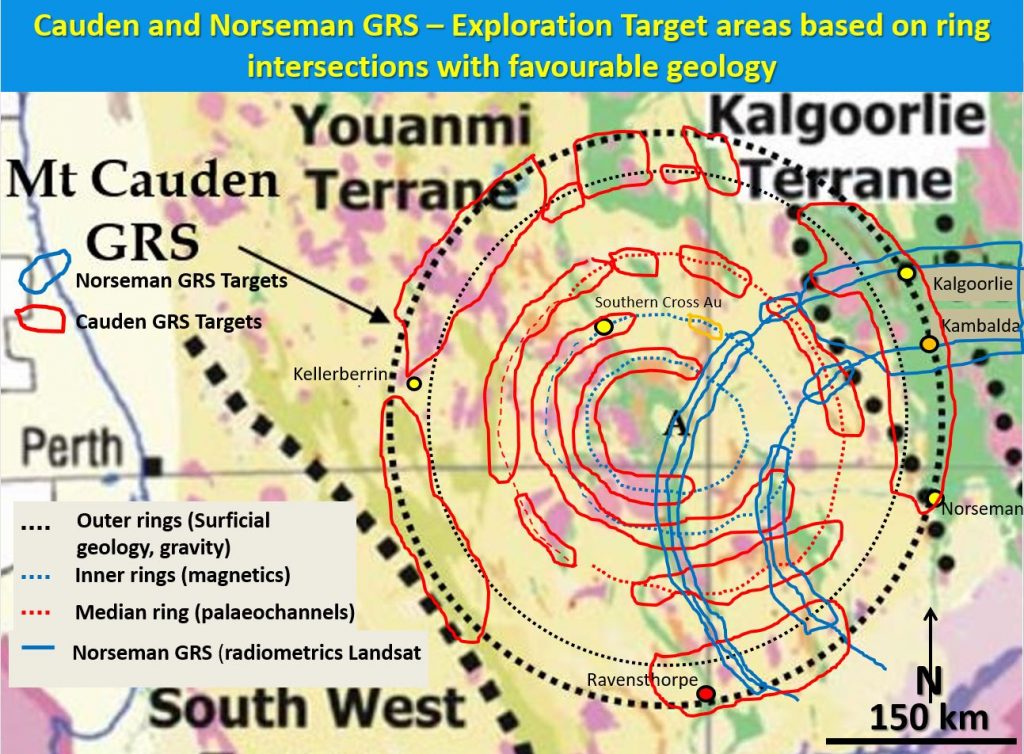YC #3. Geology, Gravity, Mineralisation and Exploration Targeting of the Yilgarn 370km Cauden Giant Ring Structure. Is this one of the world’s largest meteorite impacts?
©Robert Bingley Watchorn 22nd September 2017
Abstract
The centre of the 370km diameter Cauden giant ring structure (GRS) is located at 31˚ 40’E and 119˚40’S, about 60 km SSE of Southern Cross. The Cauden GRS was examined using residual gravity. Residual gravity highlights the near surface, heavier rock – the later greenstones. Rather than the anastomosing shear system generally attributed to the near surface geology the residual gravity highlighted a system of west facing arcs in the east and east facing arcs in the west.
Geology and Geochronology. The GRS overprinting relationships seen on the various data images and corroborative field studies done during 2016 (paper in process), suggest that the Cauden and Norseman giant ring structures were emplaced during the formation of the gneisses between 3.01 – 2.72 Ga. The Cauden GRS is examined in both the Yilgarn Craton interpreted geology and gravity data. The main, Kellerberrin, outer rim of Cauden correlates well with the near surface geology. The eastern Mt Pleasant – Kalgoorlie – Norseman arc comprises late, near surface, heavier greenstones and has a strong gravity signature which correlates with the ring seen on the surficial geology plan. These greenstones follow the ring suggesting that they intruded along the ring. The western outer Kellerberrin arc is less evident in gravity but it shows up very clearly on the surficial geology plan. The gravity of the western rim is defined by arcuate intermittent fractures and small circular gravity perturbations along the ring. The 2016 field studies confirmed that these consist of later felsic intrusives and granites presumably utilising the ring structures. These lithologies are of a similar gravity signature to the surrounding gneisses and are thus not anomalous on the gravity image.
The Cauden centre has strong correlation in the gravity. The Parker Dome lies at the centre and is gneissic granite surrounded by greenstones and iron formation sediments of 2.9 Ga age and is easily observed. These greenstones also follow the main Southern Cross NNW trends as well as along the radial structures seen in the magnetics. This suggests Cauden GRS formed prior to 2.9 Ga. The median rings are not observed in the gravity but are observed in the magnetics and surficial geology. Overall there is good correlation between the geological features highlighted in the gravity and magnetics. Thus the central and median rings highlighted in the magnetics are suggested to represent actual geological features.
There is excellent correlation of mineralisation with both the Cauden and Norseman GRSs.
Gold mineralisation. The Mt Pleasant-Kalgoorlie-Kambalda-Norseman section of the outer Kellerberrin ring encompasses >90% of the gold and nickel mined in the South Eastern Yilgarn. Why is this so? The intersection of these two outer rings (each with their own antiformal structure as observed in the seismic traveres) would form dome and basin structures. These are suggested as the focussing structural mechanism for the nickel and gold mineralisation. This research may provide an answer for the gold, and perhaps the nickel mineralisation. The gold mines also occur on the Norseman GRS arcs to the east and west where they cross the Cauden Kalggorlie arc at the giant fields of Kalgoorlie and Kambalda. This suggests that the ring structures were active throughout the time of gold mineralisation and may have provided the source and fluid pathway for the gold mineralisation.
Nickel mineralisation. The nickel mineralisation is also closely aligned with the Cauden GRS Kalgoorlie arc and the giant field of Kambalda lies right on the junction of this and the Norseman GRS arcs.
Exploration potential of the giant ring structures is examined with the definition of additional areas to explore around the Cauden and Norseman GRS, on ring/shear, ring/ring and s/favourable rock intersections.
Cauden GRS. The Cauden rings have not been previously recognised. New targeting should encompass already recognised favourable structural and lithological locii around the Cauden GRS rings especially outside the well explored Kalgoorlie Arc. This would entail mainly the NW – NE and SW – SE quadrants.
Norseman GRS. The Norseman rings have not been previously recognised. Exploration Targeting should be focussed on the corridor between the two main outer rings and for say 30 km either side. Focus should be on the intersection of favourable lithology, structures and other ring structures around the entire length of the Norseman rings. The prime areas would be the area east and west of Kalgoorlie /Kambalda and around the arcs in the Maggie Hayes and Lounge Lizard greenstone belts where they intersect the rings of the Cauden GRS.
To see more and examine new exploration areas click on the file below ……
| YC #3 Cauden Norseman GRS gravity and mineralisation correlation | 8.2 MB |
If you find it useful share with your colleagues and if you use if for further research cite it by using the following URL……

